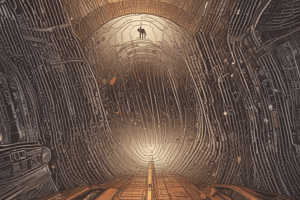Podcast
Questions and Answers
What is the primary function of physics in the field of aviation and aerospace?
What is the primary function of physics in the field of aviation and aerospace?
- Explaining and quantifying physical phenomena (correct)
- Designing aircraft and spacecraft
- Training pilots and astronauts
- Developing new materials for aircraft construction
What is the fundamental nature of matter?
What is the fundamental nature of matter?
- Matter occupies space and has mass, but is imperceptible to the senses
- Matter occupies space, has mass, and is perceptible to the senses in some way (correct)
- Matter is an abstract concept with no physical properties
- Matter can be created or destroyed
What happens to matter when it changes its physical state?
What happens to matter when it changes its physical state?
- It is destroyed and ceases to exist
- It remains the same but changes its form (correct)
- It is converted into energy
- It is transformed into a different type of matter
What are the building blocks of all matter?
What are the building blocks of all matter?
What is the characteristic that defines the type of element an atom is?
What is the characteristic that defines the type of element an atom is?
Which subatomic particle has a positive electrical charge?
Which subatomic particle has a positive electrical charge?
What is the purpose of the periodic table of elements?
What is the purpose of the periodic table of elements?
What is the simplest element, with one proton, one neutron, and one electron?
What is the simplest element, with one proton, one neutron, and one electron?
What determines the mass of an atom?
What determines the mass of an atom?
Flashcards are hidden until you start studying
Study Notes
Physics and Matter
- Physics is the study of the fundamental nature of matter and energy, focusing on how they behave rather than why.
- Physics is essential for understanding how engines work, how airplanes and helicopters fly, and other phenomena in aviation and aerospace.
Matter
- Matter is the foundation of physics, and it is what all things are made of.
- Matter occupies space, has mass, and is perceptible to the senses in some way.
- According to the Law of Conservation, matter cannot be created or destroyed, but it can change its physical state.
Atomic Structure
- All matter is made up of atoms, which are the smallest units of matter that establish the unique characteristics of a substance.
- Atoms are composed of three main parts: protons, neutrons, and electrons.
- Protons have a positive electrical charge and are found in the nucleus of all atoms.
- Neutrons have no electrical charge and are also found in the nucleus of all atoms.
- Electrons have a negative electrical charge and orbit around the nucleus in concentric shells.
Elements
- Elements are unique kinds of matter made up of atoms with different physical attributes.
- There are over 100 different elements, each with its own unique characteristics.
- Elements are arranged in the periodic table, which groups them by periods and groups to show similar characteristics.
- Each element has a distinctive atomic number, abbreviation, and inherent properties.
Atomic Number and Mass
- The atomic number of an element is determined by the number of protons in its atoms.
- The mass of an atom is related to the number of characteristic subatomic particles that make it up.
- The number of subatomic particles in an atom defines the type of element it is and its inherent properties.
Studying That Suits You
Use AI to generate personalized quizzes and flashcards to suit your learning preferences.




